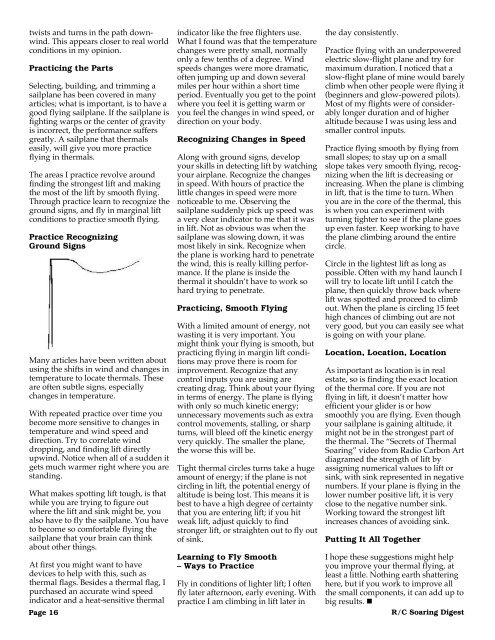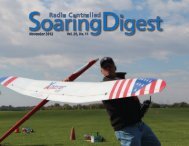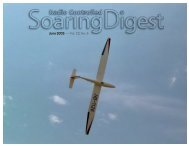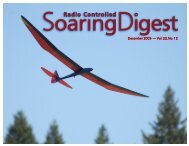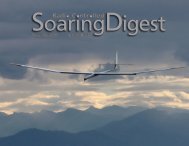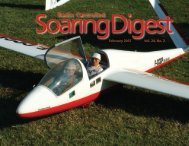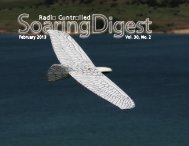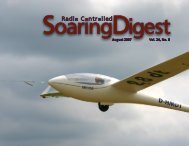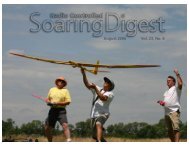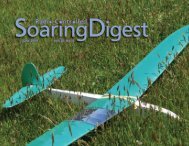4/03 RCSD - RC Soaring Digest - Rcsoaring.com
4/03 RCSD - RC Soaring Digest - Rcsoaring.com
4/03 RCSD - RC Soaring Digest - Rcsoaring.com
Create successful ePaper yourself
Turn your PDF publications into a flip-book with our unique Google optimized e-Paper software.
twists and turns in the path downwind.<br />
This appears closer to real world<br />
conditions in my opinion.<br />
Practicing the Parts<br />
Selecting, building, and trimming a<br />
sailplane has been covered in many<br />
articles; what is important, is to have a<br />
good flying sailplane. If the sailplane is<br />
fighting warps or the center of gravity<br />
is incorrect, the performance suffers<br />
greatly. A sailplane that thermals<br />
easily, will give you more practice<br />
flying in thermals.<br />
The areas I practice revolve around<br />
finding the strongest lift and making<br />
the most of the lift by smooth flying.<br />
Through practice learn to recognize the<br />
ground signs, and fly in marginal lift<br />
conditions to practice smooth flying.<br />
Practice Recognizing<br />
Ground Signs<br />
Many articles have been written about<br />
using the shifts in wind and changes in<br />
temperature to locate thermals. These<br />
are often subtle signs, especially<br />
changes in temperature.<br />
With repeated practice over time you<br />
be<strong>com</strong>e more sensitive to changes in<br />
temperature and wind speed and<br />
direction. Try to correlate wind<br />
dropping, and finding lift directly<br />
upwind. Notice when all of a sudden it<br />
gets much warmer right where you are<br />
standing.<br />
What makes spotting lift tough, is that<br />
while you are trying to figure out<br />
where the lift and sink might be, you<br />
also have to fly the sailplane. You have<br />
to be<strong>com</strong>e so <strong>com</strong>fortable flying the<br />
sailplane that your brain can think<br />
about other things.<br />
At first you might want to have<br />
devices to help with this, such as<br />
thermal flags. Besides a thermal flag, I<br />
purchased an accurate wind speed<br />
indicator and a heat-sensitive thermal<br />
Page 16<br />
indicator like the free flighters use.<br />
What I found was that the temperature<br />
changes were pretty small, normally<br />
only a few tenths of a degree. Wind<br />
speeds changes were more dramatic,<br />
often jumping up and down several<br />
miles per hour within a short time<br />
period. Eventually you get to the point<br />
where you feel it is getting warm or<br />
you feel the changes in wind speed, or<br />
direction on your body.<br />
Recognizing Changes in Speed<br />
Along with ground signs, develop<br />
your skills in detecting lift by watching<br />
your airplane. Recognize the changes<br />
in speed. With hours of practice the<br />
little changes in speed were more<br />
noticeable to me. Observing the<br />
sailplane suddenly pick up speed was<br />
a very clear indicator to me that it was<br />
in lift. Not as obvious was when the<br />
sailplane was slowing down, it was<br />
most likely in sink. Recognize when<br />
the plane is working hard to penetrate<br />
the wind, this is really killing performance.<br />
If the plane is inside the<br />
thermal it shouldn’t have to work so<br />
hard trying to penetrate.<br />
Practicing, Smooth Flying<br />
With a limited amount of energy, not<br />
wasting it is very important. You<br />
might think your flying is smooth, but<br />
practicing flying in margin lift conditions<br />
may prove there is room for<br />
improvement. Recognize that any<br />
control inputs you are using are<br />
creating drag. Think about your flying<br />
in terms of energy. The plane is flying<br />
with only so much kinetic energy;<br />
unnecessary movements such as extra<br />
control movements, stalling, or sharp<br />
turns, will bleed off the kinetic energy<br />
very quickly. The smaller the plane,<br />
the worse this will be.<br />
Tight thermal circles turns take a huge<br />
amount of energy; if the plane is not<br />
circling in lift, the potential energy of<br />
altitude is being lost. This means it is<br />
best to have a high degree of certainty<br />
that you are entering lift; if you hit<br />
weak lift, adjust quickly to find<br />
stronger lift, or straighten out to fly out<br />
of sink.<br />
Learning to Fly Smooth<br />
– Ways to Practice<br />
Fly in conditions of lighter lift; I often<br />
fly later afternoon, early evening. With<br />
practice I am climbing in lift later in<br />
the day consistently.<br />
Practice flying with an underpowered<br />
electric slow-flight plane and try for<br />
maximum duration. I noticed that a<br />
slow-flight plane of mine would barely<br />
climb when other people were flying it<br />
(beginners and glow-powered pilots).<br />
Most of my flights were of considerably<br />
longer duration and of higher<br />
altitude because I was using less and<br />
smaller control inputs.<br />
Practice flying smooth by flying from<br />
small slopes; to stay up on a small<br />
slope takes very smooth flying, recognizing<br />
when the lift is decreasing or<br />
increasing. When the plane is climbing<br />
in lift, that is the time to turn. When<br />
you are in the core of the thermal, this<br />
is when you can experiment with<br />
turning tighter to see if the plane goes<br />
up even faster. Keep working to have<br />
the plane climbing around the entire<br />
circle.<br />
Circle in the lightest lift as long as<br />
possible. Often with my hand launch I<br />
will try to locate lift until I catch the<br />
plane, then quickly throw back where<br />
lift was spotted and proceed to climb<br />
out. When the plane is circling 15 feet<br />
high chances of climbing out are not<br />
very good, but you can easily see what<br />
is going on with your plane.<br />
Location, Location, Location<br />
As important as location is in real<br />
estate, so is finding the exact location<br />
of the thermal core. If you are not<br />
flying in lift, it doesn’t matter how<br />
efficient your glider is or how<br />
smoothly you are flying. Even though<br />
your sailplane is gaining altitude, it<br />
might not be in the strongest part of<br />
the thermal. The “Secrets of Thermal<br />
<strong>Soaring</strong>” video from Radio Carbon Art<br />
diagramed the strength of lift by<br />
assigning numerical values to lift or<br />
sink, with sink represented in negative<br />
numbers. If your plane is flying in the<br />
lower number positive lift, it is very<br />
close to the negative number sink.<br />
Working toward the strongest lift<br />
increases chances of avoiding sink.<br />
Putting It All Together<br />
I hope these suggestions might help<br />
you improve your thermal flying, at<br />
least a little. Nothing earth shattering<br />
here, but if you work to improve all<br />
the small <strong>com</strong>ponents, it can add up to<br />
big results. <br />
R/C <strong>Soaring</strong> <strong>Digest</strong>


